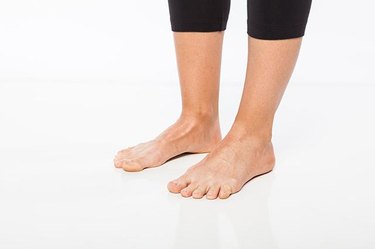
You may not give your feet and ankles a lot of thought, but you use them in almost every workout you do! Whether you're a runner, cyclist, yogi, CrossFitter or Zumba dancer, strengthening and stretching the muscles in your ankles and feet can help improve your balance, performance and comfort.
Ankle exercises and mobility drills are a quick addition to your regular workout routine and will help keep you injury-free. According to the Academy of Orthopedic Surgeons, ankle exercises help improve the strength and flexibility of the ankle joint. That helps improve your balance and prevent falls.
Or, if you're feeling soreness or tightness in your ankle, these exercises can also help reduce the pain by increasing circulation and lubrication of the joints.
That's why we asked Katy Bowman, biomechanist and founder of Nutritious Movement, to create a routine with feet and ankle exercises you can do at home.
Bowman recommends doing this 15-minute routine barefoot every day (or as often as possible). Do all the movements in order or do them separately (in any order) whenever you can squeeze them in. Kick off your shoes and grab a towel, tennis ball and a few throw pillows.
Move 1: Single-Leg Balance
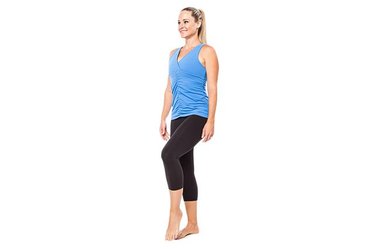
This single-leg balance can be challenging at the foot or ankle — but it also helps strengthen the quadriceps (upper thigh) muscles, which assist with ankle stabilization, so that there aren't any areas of weakness in your kinetic chain (in this case, your lower-body muscles), Bowman says.
- Stand on the left leg with knee straight (but not locked) and bend the right knee to lift the right foot slightly off the floor, balancing for up to one minute before switching legs.
- Repeat up to three times on each leg for strength work.
Tip
To make this more challenging, Bowman recommends keeping your arms down by your sides, letting your hips do the work.
Move 2: Single-Leg Towel Balance
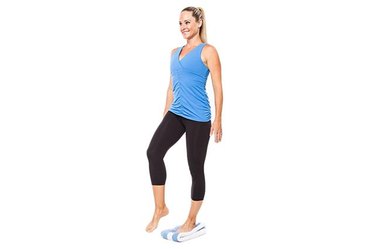
Though it seems similar to the previous exercise, the towel adds a unique surface (similar to the varying terrain we walk on) that will deepen the work in the foot, ankle and thigh muscles.
- Fold a towel several times and repeat the single-leg balance while standing on top of the towel, balancing for up to one minute before switching legs.
Tip
Try closing your eyes when you do balance exercises. Ankle sprains often happen when you're walking or running in one direction while looking in another, Bowman says. "Developing the strength and skill to stabilize your body without visual support can come in handy when you head to your workout.”
Move 3: Active Toe Spreading
A lifetime of footwear can decrease the intrinsic strength the muscles of your feet would build walking around barefoot. According to Bowman, this exercise helps to restore foot strength.
- Stand with feet about hip-width apart and spread your toes as wide as possible, keeping them flat on the ground as you create space between each toe.
- Repeat as often as you like, with or without shoes, throughout the day.
Move 4: Great Toe Lift
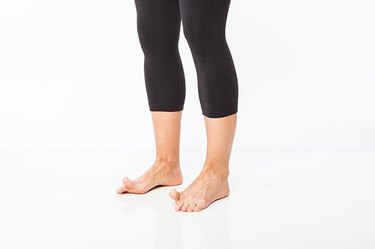
The muscle group that lifts your big toes (the extensor hallucis group) is one of the strongest muscles in the foot, Bowman says, and restoring strength to the group can assist in restoring strength and motor control of the foot and stability of the ankle.
- Stand (or sit) with feet about hip-width apart.
- Keeping all the other toes on the ground, lift just your big toes off the floor, and then lower.
- Repeat one to three times.
Tip
To make this more challenging, Bowman recommends eliminating sideways motion of the big toe as it lifts. “[The big toe] should lift up, not lift up and go sideways,” she says.
Move 5: Walk on The Pillow Train
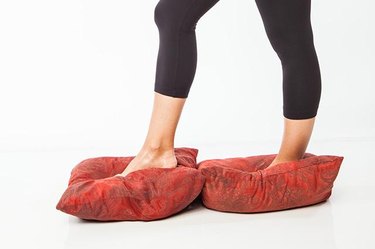
Walking on this type of uneven "terrain" helps expose the muscles of the feet and ankles to unique angles and workloads, Bowman says.
- Create a short "train" of various sized pillows and cushions on the floor.
- Walk a few laps back and forth on top of the pillows.
Tip
If you don’t want your pillows to touch your floor, you might try placing them on top of a mat or a towel.
Move 6: Wheelies
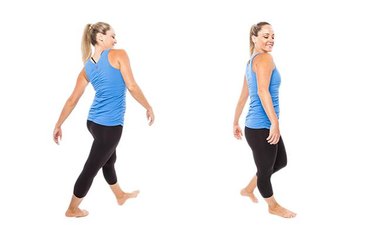
"This simulation loads the ankle in constantly varying ways, many of which are found in movement programs or athletics," Bowman says. "Since most of the time we walk on flat ground, as opposed to continuously different surfaces, we are weak when new angles present themselves. Wheelies help to recreate those angles in a controlled environment, and they can aid in creating a more stable ankle in any environment."
- Stand with feet hip-width apart and arms by your sides.
- Push the pelvis out to the right, leaning into the right hip and begin walking quickly in a full circle from right to left, leaning into the right hip the entire time.
- Walk in a circle two to three times in a row, and then repeat on the opposite side.
Move 7: Calf Stretch (Gastroc)
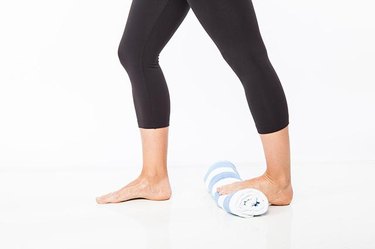
"This stretch targets the larger of the main calf muscles, the gastrocnemius muscle, which can become tight due to the excessive frequency of knee flexion found in chronic sitting," Bowman says. "The better the range of motion in this muscle, the more 'oomph' you can get from your lower body without the 'ouch' in the knees."
- Roll up a towel and stand with the right foot on top of towel, with your heel pressed into the floor, leg straight.
- Step forward with the opposite leg to increase the stretch.
- Hold for 30 to 60 seconds, then repeat with the other leg.
- Do this as a circuit three times.
Move 8: Calf Stretch (Soleus)
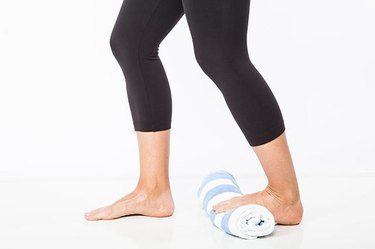
"This stretch targets the fibers of the soleus (the lower muscle on the calf) and the Achilles tendon, both which shorten over time due to heeled footwear, certain gait/running patterns, and during some strength building movements such as calf raises," Bowman says.
- With the towel still rolled, stand with your right foot on top of towel, with your heel pressed into the floor, and bend your right knee without lifting your heel.
- Hold for 30 to 60 seconds, and then repeat on the left.
- Do this as a circuit three times.
Move 9: Passive Toe Spreading
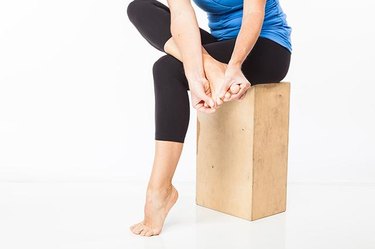
Toe abduction (separation) mobilizes the bones, muscles and connective tissues for better intrinsic foot muscle strength, circulation and nerve health, Bowman says.
- Sitting on a chair, cross an ankle over the opposite knee.
- Using your hands, gently spread your toes apart, stretching the toes away from each other.
- If your feet are tight and cramp up on you, start with a little spreading for a shorter period of time, about 15 seconds. Over time, hold for longer (up to a minute or so).
Move 10: Top of the Foot Stretch

- Stand on your right leg with your arms by your sides and reach your left leg behind you.
- Curl your left toes under and gently press your ankle to the floor until you feel a stretch along the top of your foot.
- Hold for up to a minute. Cramping on this one is normal, so start with shorter holds and progress to longer.
- Repeat a few times on each foot.
Move 11: Standing Foot Massage
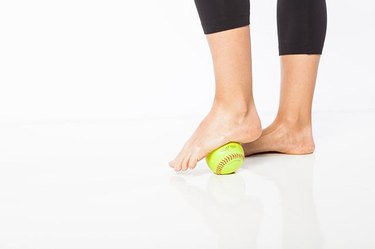
"There are 33 joints in the foot that would normally be mobilized by walking over small pebbles, sticks and varying terrain," Bowman says. "Because our feet are only exposed to a flat sole and flat ground, these joints become immobile and the muscles that connect them are extremely stiff and atrophied. Working the foot over the ball introduces a range of motion to these joints."
- Start standing with a tennis ball (or similar sized ball) under the arch of one foot.
- Slowly load your weight onto the ball, moving the foot forward and back to apply pressure to individual joints within the foot.
- Work the sole of foot with the ball, applying more or less pressure as needed.
- Do this for up to three minutes per foot.
Move 12: Forward Bend
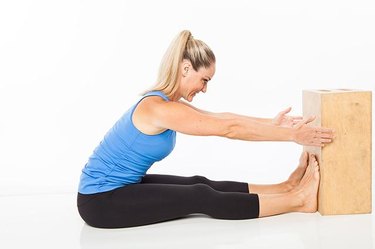
"The effects of wearing high-heeled footwear and certain gait patterns can shorten the muscles and connective tissues running from the soles of the feet to the top of the head," Bowman says. "Stretching against the wall stabilizes the ankle to create a tensile load down the entire 'back line' of the body to help restore joint mobility."
- Sit on the floor with your feet pressed flat against a wall. If your hamstrings are really tight, Bowman suggests sitting on a pillow.
- Fold forward, tipping the pelvis toward the wall as you lean into your legs, reaching with your arms toward your feet.
- Hold for up to 60 seconds.
